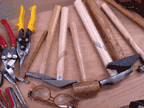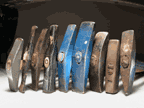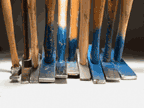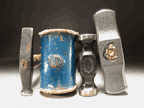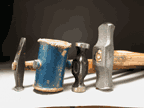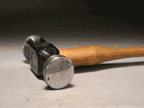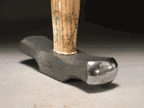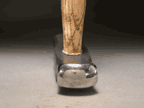| Metal for practicing: I recommend thin copper sheet, 24 gauge (0.5mm) is best, sold often as 'roofing copper'. In the US it is sold as well as .016 copper and 16 ounce copper. Aluminum sheet of the same guage can be used instead and is cheaper. The techniques may be used with most metals including gold alloys, silver alloys, platinum, aluminum, niobium, titanium, and steel. |
Basic Tools Ear muffs or plugs Safety glasses Selection of Hammers: Raising/forging hammers are very important. Mallets: Leather and paper mallets are most useful Anvils and Stakes Pliers, both chain nose, flat and wide jawed. Prying tools like a knife , altered screwdriver or T-handled prying tool Large mounted vise, smooth topped if possible. A Blacksmith's Leg or post vise is useful.
|
|
|
|
|
The forging hammers are used to stretch the metal directionally. The 'thumblike' hammer is used for thinning and for creating centered line folds. The planishing hammer is used for smoothing and also for upsetting and confirming fold edges on line folds. |
|
|
|
|
|
|
|
|
If you would like to buy a set of fold-forming hammers email us and we'll connect you with a vendor.
|
See
the new Foldforming
Step-by-Step Powerpoint Introduction
Charles Lewton-Brain's Articles
at the Ganoksin Project
Brain Press Books List
Book Reviews
Search
the Ganoksin Web Site
for Jewelry information
Brain
Press
